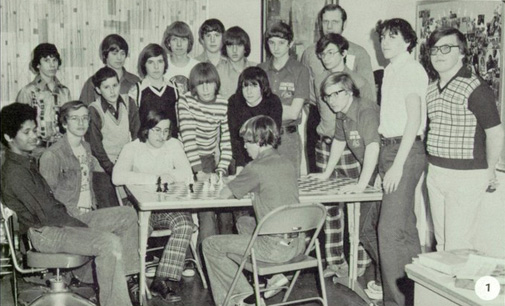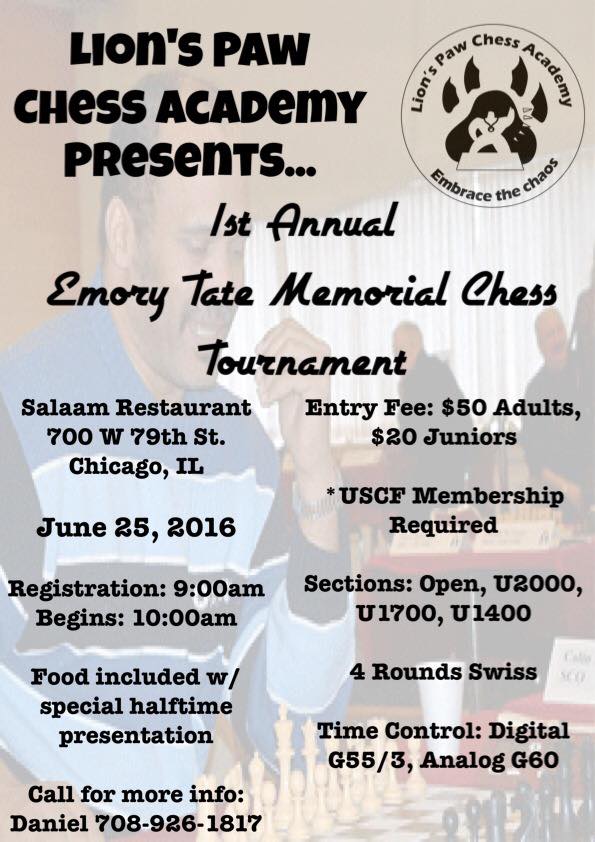Chicago to hold Emory Tate Memorial on June 25th
.jpg)
Emory Tate away last October, but left behind a legacy that will last for an eternity. There have been a number of memorial tournaments held in his honor and the latest will be hosted by the Lion’s Paw Chess Academy in Chicago on June 25th at the Salaam Restaurant on West 79th Street. After his death last October 27th (death, obituary, funeral), there were literally thousands of tributes recounting stories of his impact. On June 25th, players in the Chicago area will honor a hometown hero with a 5-round Swiss tournament. The event expects to draw a large number of players from Chicago and perhaps the surrounding states. Organizer Daniel X Jones is hoping that this event become an annual tribute.
Tate was born on the Westside of Chicago along with his four sisters. Combined with his four half-siblings, he came from a large family with a domineering father, a successful attorney with a private practice. His mother was a hard-working woman from rural Alabama who had vision of success for her children. At the age of 13, Emory moved with his family to Elkhart, Indiana where he became the valedictorian of Concord High School. He was also on the wrestling team and was working his up the ladder in the chess club. It was there that the dormant interest in chess blossomed into a passion and young Tate worked hard to improve.

Concord H.S. Chess Club, Elkhart, Indiana (1976)
After earning a scholarship to Northwestern, he took his growing interest after defeating GM Arthur Bisguier in a simul. Many chess players remember Tate being at Ron’s Chess Shoppe and other venues in the Chicago area. During this era of his life, his confidence soared and he became a sensation after developing his hyperactive tactical style.
Apart from his sparkling play was the influence he had on the chess community. Tate’s games were always full of creative ideas and he was always willing to share his ideas in a demonstrative way. His generosity is one of the redeeming qualities he is remembered for and is why he had such a large fan base. He will be aptly honored the community where he had such an impact, the southside of Chicago. See flyer below for details.


I first met Emory at the World Open in 2000!
The whole tournament we and others would all hang out, play skittles, and just talk chess!
At the end of the tourney, Emory drove myself and a few others to the airport!
He was way cool!
Wow Tate was born in Chi-town 2? How amazin is that!!! lol What a great Player, have fun at the practice event! CHESS.
Monin drummas we bout dat work today? I like Emory’s Cookie Bush in the photo!!! hahaha Nice Daaim.
Often times when we have been conditioned by “another” then we cannot see our own TRUTH!!! Pursue your own TRUTH IN CHESS and nothing will stop you, right adia?
Good luck to all concerned!!
Well how did u expect AFRICAN AMERICAN CHESS GENIUS to be Chessrummas? Buffalonians? Adia? Sophie Gurl? Frankie J? Alex King of NYC?
It’s wonderful to have an event such as this. I first met Tate In Chicago back in the day, and later while in the USMC playing against him in the Armed Forces championship from 1983-89. We shared some good times together.
He will be missed.
What a great adventure it has been, my friend.
My name is Robert sanders , I met IM Emory Tate back in the
Day when the late Mr Ron Washington had his chess club some where
Near down town Chicago. I would spend extra time just to
Watch IM Tate play the Sicilian defense,and annotate as he played
It was like watching a chess play or being part of a chess class,
I have not been on the chess tournament track but I have always
Followed IM Emory Tate chess Quest. An eternal brother and fan
Love to you Brother Tate.
Robert L Sanders
FOR IMMEDIATE RELEASE
Contact: Daaim Shabazz, The Chess Drum
P.O. Box 7663
Tallahassee, FL 32314-7663 USA
webmaster@thechessdrum.net
(850) 296-9494
Tallahassee, USA – 11 March 2017 – Emory Tate’s biography Triple Exclam!!! The Life and Games of Emory Tate, Chess Warrior has finally arrived and is available for purchase. The book details the life of one of the most colorful figures on the U.S. chess circuit. Tate’s death on October 17, 2015 brought an end to the adventurism and sense of wonderment he found in chess.
In just over a year, his biography has been published by The Chess Drum after finishing production in March 2017. Release was delayed for months by a number of technical issues. The book covers his exciting 56-year journey and life as a chess artist. His passion for chess was truly inspiring. Triple Exclam was the culmination of an intense research effort on the life of Tate.
The following blurb appears on the inside flap of the dust jacket:
ISBN-10: 0998118001
ISBN-13: 978-0998118000
Shipping Weight: 2.3 pounds
Publisher: The Chess Drum, LLC
Retail Price: $40.00 (full color, hard back)
TO ORDER NOW… CLICK HERE!
The Book
Triple Exclam is a hardback, full-color edition that includes 280 pages in 12 chapters and seven appendices surveying the life of Tate. It includes 35 of his games (all annotated) and vintage photos at various stages of his life. The book also includes chapter notes and is fully-indexed. If you are not a chess-player but enjoy biographies, you will appreciate his story.
The Foreword of the book was done by GM Maurice Ashley with annotations by GM Yasser Seirawan, GM Alejandro Ramirez, GM Pontus Carlsson, GM Amon Simutowe, GM Kenny Solomon, IM Malcolm Pein, FM William Morrison, FM Todd Andrews, FM Jimmy Canty and National Masters Ernest Colding, Glenn Bady and Dr. Okechukwu Iwu. Two games feature transcribed annotations from Tate’s famous post-mortems.
(Previews)
Order Details
The highly-anticipated book can be purchased by following the Paypal button below. A Paypal account is not needed. Buying in bulk cuts per unit and mailing costs, so for groups of friends, chess clubs, and vendors seeking volume discounts (for the purchase of five or more), click here!
International rates are currently prohibitive unless ordering quantities in multiples of five (U.S. Postal Service flat rate box). The Chess Drum is looking for international distributors to make the book accessible to a wider audience. An e-book version of Triple Exclam is forthcoming.
Some customers many be skittish about ordering online. In that case, contact me at webmaster@thechessdrum.net with number of copies needed and I’ll send an invoice. Also available for book signings. Make sure you add this handsome book to your collection!
FOR PURCHASING 5 OR MORE COPIES, click here!
# # #
The Chess Drum, LLC is a publisher of chess news content and literature. The organization’s website has continued to demonstrate the universality of chess by covering a variety of topics through news stories, essays, interviews, and photos since 2001. Visit The Chess Drum at thechessdrum.net and follow the beat on Facebook and Twitter!
You have a perfect blog with all news. Living in Chicago, had no idea regarding this event. Let’s cooperate? Call us or write – https://www.chesswizards.com